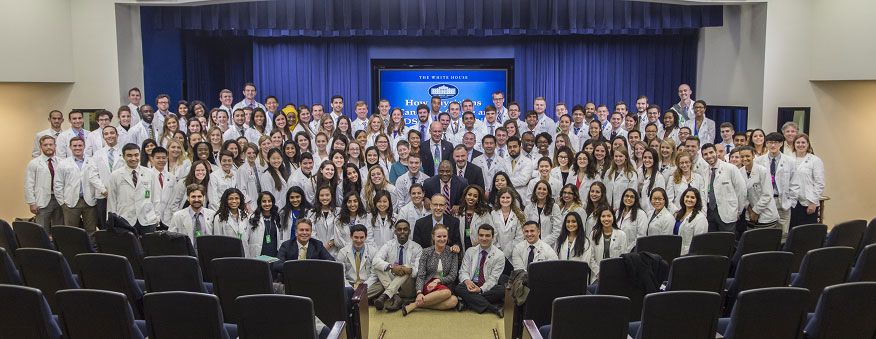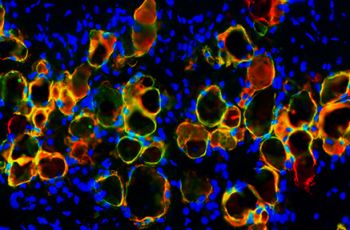
First-year GW School of Medicine and Health Sciences (SMHS) medical students Kerry Townsend and Erin Good describe themselves as “the perfect combination;” Townsend, who interned at the White House Office of Health Reform before attending SMHS, has an affinity for health policy, while Good, a former AmeriCorps member, has focused on community health. Together, they made an ideal pair to lead the Washington, D.C. student group during the fall M.D. program intersession, “How Physicians Can Help Create an AIDS-Free Generation.”
“[Our experiences] gave us a really good dual interface for understanding the issues and ways to implement [ideas], both on the policy side and the community side,” Good said.
Having just completed their coursework in immunology and pathogenesis, Good and Townsend, along with their fellow first-year students, embarked on the three-day intensive look at the HIV/AIDS epidemic on Dec. 14. Their immersion in the issue comes as part of the revised M.D. curriculum, which places increased emphasis on clinical public health.
“One of the things that’s really been so exciting about the revision of the M.D. curriculum has been what we call ‘clinical public health,’ this deep integration of the principles and practices of public health such as epidemiology, health policy, and population sciences into clinical medicine,” said Jeffrey S. Akman, M.D. ’81, RESD ’85, vice president for health affairs, Walter A. Bloedorn Professor of Administrative Medicine, and dean of SMHS. “Ultimately, [we want] to create physician-advocates. I want to see our graduates making an impact in their communities, in their states, and around the world.”
Anthony S. Fauci, M.D., director of the National Institute of Allergy and Infectious Diseases at the National Institutes of Health, opened the first day of intersession, relating his own history and successes combating the epidemic. In 1981, Fauci read in the Morbidity and Mortality Weekly Report about the deaths of five young gay men, each of whom had suffered from Pneumocystis carinii pneumonia. As more cases occurred, Fauci, an infectious disease immunologist at the time, suspected all of the patients were suffering from the same virus. He changed career paths to investigate the new syndrome and formed the first AIDS group at the National Institutes of Health.
“Let’s fast forward 34 years,” Fauci said. “When I started doing this, there were about 149 reported cases. Now, in the year 2015, there are over 70 million people having been infected, 37 million people living with HIV, 1.2 million deaths, and 2 million new infections. We still have a long way to go.”
In Washington, D.C., for example, 2.5 percent of the population has HIV, according to Fauci; the World Health Organization classifies a generalized epidemic as 1 percent. There are between 12,000 and 14,000 people living with HIV in the District, and at least one-third of all new diagnoses occur in patients between the ages of 13 and 24. Despite the numbers, Fauci said, there has been progress. Presidents and policymakers have prioritized HIV/AIDS research and funding, and with the development of effective combination therapies, patients can now manage their HIV as a chronic disease.
“Today, in December of 2015, even without a cure or a vaccine, we have all the tools that are necessary to end the AIDS epidemic,” Fauci said. “There can be no excuse for inaction.”
Fauci and speakers Maggie Czarnogorski, M.D., RESD ’06, FEL ’08, M.P.H. ’14, deputy director of women’s health and acting deputy director of strategic partnerships at the Department of Veterans Affairs, and Terrance Moore, deputy executive director at the National Alliance of State and Territorial AIDS Directors (NASTAD), charged students with continuing to search for solutions.
“Everything you say and do to your patients will have a lasting impact,” said Moore. “That’s the key piece in this: figuring out ways to meet people where they are. The science is going to continue to change; it’s changing as we speak. But the question is, can you connect with someone in a way they’re going to feel important and they’re going to want to come back to you?”
Following Moore’s statement, the Class of 2019 met face-to-face with leaders on the front lines of the HIV/AIDS fight in Washington, D.C., Tennessee, San Francisco, and New York City to address issues specific to those jurisdictions. The leaders — Michael Kharfen, senior deputy director of HIV/AIDS, Hepatitis, STD, and TB administration at the Department of Health in Washington, D.C.; Shanell McGoy, Ph.D., M.P.H., director of HIV/STD with the Tennessee Department of Health; Oliver Bacon, M.D., M.P.H., associate professor at the University of California, San Francisco, School of Medicine; and Demetre Daskalakis, M.D., assistant commissioner with the Bureau of HIV Prevention and Control, New York City, Department of Health and Mental Hygiene — participated with support from NASTAD.
As treatments for HIV and AIDS have improved since the early 1980s, strategies for ensuring care have evolved; Washington, D.C. has several initiatives for promoting testing and immediate treatment. “Red Carpet Entry,” for instance, guarantees patients receive an appointment with an HIV specialist within 72 hours of their diagnosis.
The city is also following a directive from Mayor Muriel Bowser known as “90-90-90-50.” “What we’re trying to achieve is [minimum] 90 percent of persons with HIV know their status; a minimum of 90 percent of persons who have HIV, or are diagnosed with HIV, are on treatment; and 90 percent viral load suppression,” Kharfen explained. “The 50 is that we’ll get a 50 percent reduction in new HIV cases by the year 2020.”
For Good and Townsend, the crux of the HIV/AIDS epidemic came with conflicting language, an obstacle they intended to tackle during the second day of intersession, when their group made site visits to Whitman-Walker Health; HIPS, an HIV/AIDS health advocacy organization; and needle exchange locations. Good pointed to the language of “high-risk behaviors,” which, for some patients, may be entirely normal, while Townsend noted contradictory advertising messages.
“I think the biggest thing for me is the difficult dichotomy between advertising that you need to get tested, you don’t want to get this disease, be safe, protect yourself — kind of a fear tactic — and then ‘oh, but if you get it, we’ll take care of you,’ and ‘it’s going to be ok, it’s not that scary,’” she said.
With those conflicts in mind, the Washington, D.C. intersession group, as well as the other state and local groups, devised solutions for four areas: HIV testing and linkage to care; access and adherence to HIV services and support; access to intravenous drug user services and support; and pre-exposure prophylaxis and non-occupational post-exposure prophylaxis. On the final day of intersession, the students, invited by “AIDS Czar” Douglas M. Brooks, MSW, director of the Office of National Aids Policy at the White House, presented their ideas, many of which incorporated the use of social media and novel user apps, to a panel of experts.
Members of the panel included moderator Brooks; Kharfen; McGoy; Alan Greenberg, M.D., M.P.H., professor and chair of the Department of Epidemiology and Biostatistics at the GW Milken Institute School of Public Health; Ron Valdiserri, M.D., M.P.H., deputy assistant secretary for Health for Infectious Diseases and director of the Office of HIV/AIDS and Infectious Disease Policy with the U.S. Department of Health and Human Services; and Heather Hauck, MSW, LICSW, director of the Division of State HIV/AIDS Programs at the HIV/AIDS Bureau with the Health Resources and Services Administration.
“It’s amazing; [I’m] blown away,” Good said. She added that “one of the main reasons I came to GW was because integrated clinical public health is in our curriculum. I think that [today] is a great example of something that shows us both the medical side and integrating policy and public health.”
Initially, Good and Townsend said, ideas such as expanding needle exchange programs to tattoo parlors and pharmacies, or establishing a web-based, peer mentorship platform, seemed formidable. “Now, these aren’t lofty,” Good said. “We can actually do these. It’s pretty cool to me to see that.”
The members of the panel were enthusiastic about the students’ work (“These are a lot of great ideas I’m going to take back to the team,” Kharfen said), as were Lawrence “Bopper” Deyton, M.D. ’85, M.S.P.H., senior associate dean for clinical public health and professor of medicine at SMHS, who spearheaded the intersession, and Akman.
“You are in the right place to do this kind of work; you’re in Washington, D.C., and you’re at GW,” said Akman at the conclusion of the intersession. “We want to create doctors who really make a difference, and this is a great start. I’m thrilled that you’re here and extremely proud of you.”


